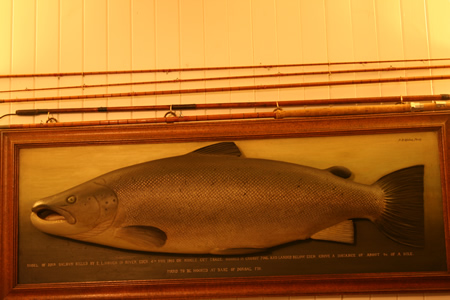These bulletin blogs represent news about Finavon and the South Esk, and my views as a riparian owner. They are not the views of any other organisation, nor are they designed to promote the interests of any individual or organisation other than Finavon Castle Water and factors affecting the fishery. Tony Andrews
We caught 8 salmon and 8 sea trout last week. The late flurry of sea trout catches is not unusual and these fish are in general well advanced in their readiness to spawn, which normally happens in October & November.
On Saturday, after a day and a night of rain, some of it torrential, the river came up and only started to drop away in the early hours of Sunday morning. That gave Moray time to fish Milton Beat in the late afternoon on Saturday, where he caught three sea trout and saw a pod of very big fresh salmon running through and rolling their backs above the surface of the water in Willows and Volcano. He estimated all four to be in the late teens or early twenties of lbs.
This is the sort of autumn salmon that was commonplace in the early decades of the twentieth century. The model of this 32 lbs salmon was made from carved wood by Mallochs of Perth. It was caught on the Cumberland Eden at Crosby in November 1903 by my great-grandfather, Edwin Hough. I have always imagined that the gene that made me a fisherman came from him! I hope that we may see the occasional fish like this one at Finavon in the next two or three years. Indications are that our MSW salmon that feed in the Greenland fjords are accessing an abundance of prey species that could give us some big fish, by which I mean 25lbs+.
The appearance of big MSW salmon confirms the predictions made by scientists that fish that feed in the productive, nutrient-rich waters of the Irminger and Labrador seas, could become larger. Numerical abundance is another matter because of the simple logic that the longer salmon remain at sea, fewer will return. The corollary unfortunately is that the one sea winter fish – grilse -do not travel as far as their MSW siblings and extended family members, and the feeding areas they use, mainly in the nutrient ‘patchy’ eastern Atlantic, fail to provide them with the food they need to achieve the condition of salmon using the western Atlantic feeding areas. I can’t help wondering how many of these half-starved grilse never make it back home, but, weakened by lack of food they are open to disease, predation and inability to meet the challenge of the long swim home. It doesn’t surprise me that those that do make it back – the survivors – often look like kelts, rather than well conditioned fish bound for the spawning redds.
Maybe someone will catch a ‘big fish’ at Finavon this autumn. Here’s hoping!
TA
